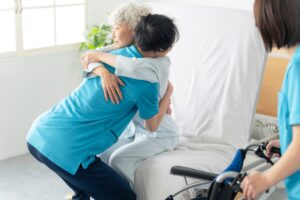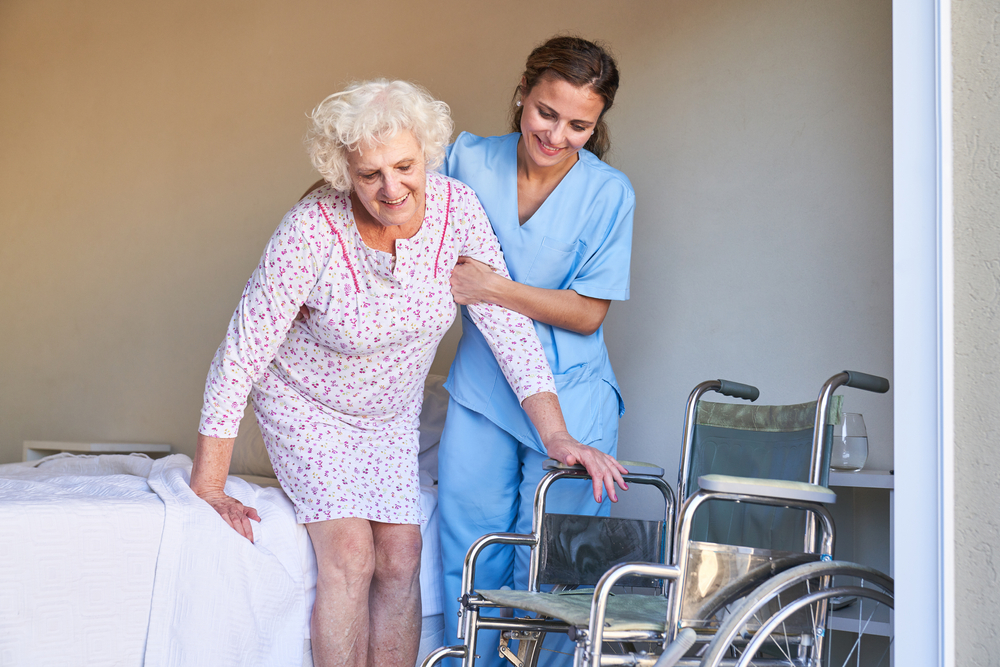When you’re caring for someone who has trouble moving around, whether due to age, illness, or injury — mobility becomes a daily challenge. But with the right techniques, it doesn’t have to feel overwhelming. Safe, effective movement isn’t just about getting from point A to B — it’s about preserving dignity, reducing injury risk, and helping your loved one feel more confident and independent at home.
This guide walks through essential mobilization techniques for caregivers, designed to make everyday movement safer and more manageable.
Why safe mobility support matters at home
Preventing falls and injuries
Falls are one of the leading causes of injury for older adults — and improperly helping someone move can put you at risk too. Supporting someone with poor balance, limited strength, or fatigue requires care and strategy. Using the right safe lifting techniques for home care keeps everyone protected.
Preserving dignity and independence

Helping someone move isn’t just physical; it can be emotional. Awkward or unsafe transfers can feel embarrassing or even scary. Gentle, respectful mobility support helps maintain routines and fosters a sense of independence — and that matters more than most people realize.
Supporting recovery and physical health
After surgery, illness, or flare-ups of chronic conditions like Parkinson’s or MS, movement is part of the healing process. Proper mobility support encourages circulation, reduces stiffness, and builds strength over time. The goal isn’t just to help them move — it’s to help them heal.
Read more: Mobility and daily care for adults with disabilities
Mobility techniques every caregiver should know
Safe lifting and transfer techniques
You don’t need to be strong — you just need to be thoughtful about how you move. These simple habits can help you and your loved one stay safe and avoid injury:
- Stay close when helping someone move — don’t reach or twist.
- Keep your back straight. Bend at the knees and lift with your legs.
- Avoid sudden movements. Count down together so you’re moving in sync.
- Move smoothly, and don’t pull from the arms or underarms — it can hurt more than help.
Common transfers and how to handle them:
- Bed to chair: Try a pivot transfer. Angle the chair about 45 degrees, lock the wheels, and help guide them in one steady motion.
- Toilet transfers: Use grab bars or a raised seat if available. Stand with your feet apart so you stay balanced.
- Getting up from a chair: Have them lean forward and push with their legs, not just their arms—that’s where most of their strength comes from.
Using assistive devices to support safe movement
You don’t have to do it all with your body. Assistive devices are made to protect both the caregiver and the person receiving care.
Here are a few tools that can make mobility safer and easier at home:
- Gait belts – Help stabilize the person during walking or transfers.
- Walkers & rollators – Offer balance support and reduce the risk of falls.
- Transfer boards – Great for helping someone slide between surfaces (like bed to wheelchair).
- Canes – For individuals who need just a bit of support with balance.
- Grab bars & raised toilet seats – Add stability in the bathroom, where falls often happen.
Want more ideas for home setup? These bathroom safety modifications can be especially helpful.
Tip: Learn how each device works before using it. A physical therapist or home health aide can help guide you.
Supporting Ambulation
Helping someone walk safely (also called “ambulation”) requires patience and awareness.
Safe ambulation techniques:
- Stand slightly behind and to the side, holding a gait belt (if used).
- Watch their steps, posture, and signs of fatigue.
- Encourage short walks frequently throughout the day to build strength.
- Don’t rush. Give them time to pause and rebalance.
Watch for signs they may need to rest:
- Sudden heaviness or leaning
- Shortness of breath
- Complaints of pain or dizziness
Remember: Mobility support should feel empowering, not exhausting.
Read more: Simple fall prevention strategies
If your loved one has a specific condition
If you’re helping someone manage a specific condition, certain aspects of care can get more complex. Supporting someone through the early signs of Parkinson’s, caring for people with multiple sclerosis, or assisting children with cerebral palsy all comes with its own set of challenges — and a little extra guidance can go a long way.
Training and support for caregivers
Learning from home health professionals
You don’t have to figure it all out on your own. Nurses and physical therapists can show you how to assist with patient transfers, use equipment properly, and avoid common mistakes. If a professional is already visiting your loved one, don’t hesitate to ask questions or ask them to walk you through what they’re doing — so you can feel more confident when you’re on your own.
At Americare, our compassionate care team works closely with families to build skills and confidence, so everyone feels supported and knows how to care safely and comfortably at home.
Online and local resources
If you’re looking to learn more or connect with others, you’re not alone — and there’s help out there.
Helpful places to start:
- Video tutorials – If you want to see these techniques in action, AARP’s Family Caregiving Video Library is a great place to start. The videos are clear, practical, and made specifically for family caregivers.
- Support groups – Check out online support forums where caregivers share advice, ask questions, and talk openly about the challenges of caring for a loved one. Even just reading through others’ experiences can be reassuring—especially when you’re feeling isolated or unsure.
- Local programs – Many hospitals, senior centers, and community health organizations offer free caregiver workshops or safety trainings. Ask your doctor, physical therapist, or local Area Agency on Aging if they know of any near you.
And remember: if you’re working with a home care agency, they may already have resources or training materials to share — don’t hesitate to ask.
Contact Americare for support
If someone you love needs help with daily mobility, you’re not alone — and you don’t have to figure it out by yourself. Contact our team to learn how our caregivers can support safe, confident movement at home.

